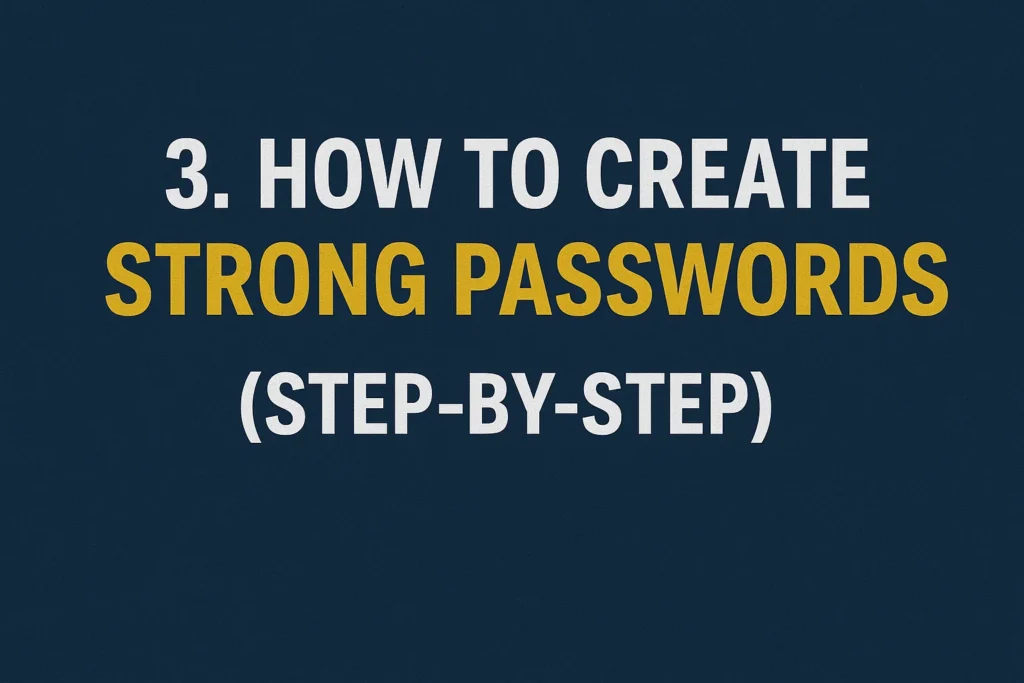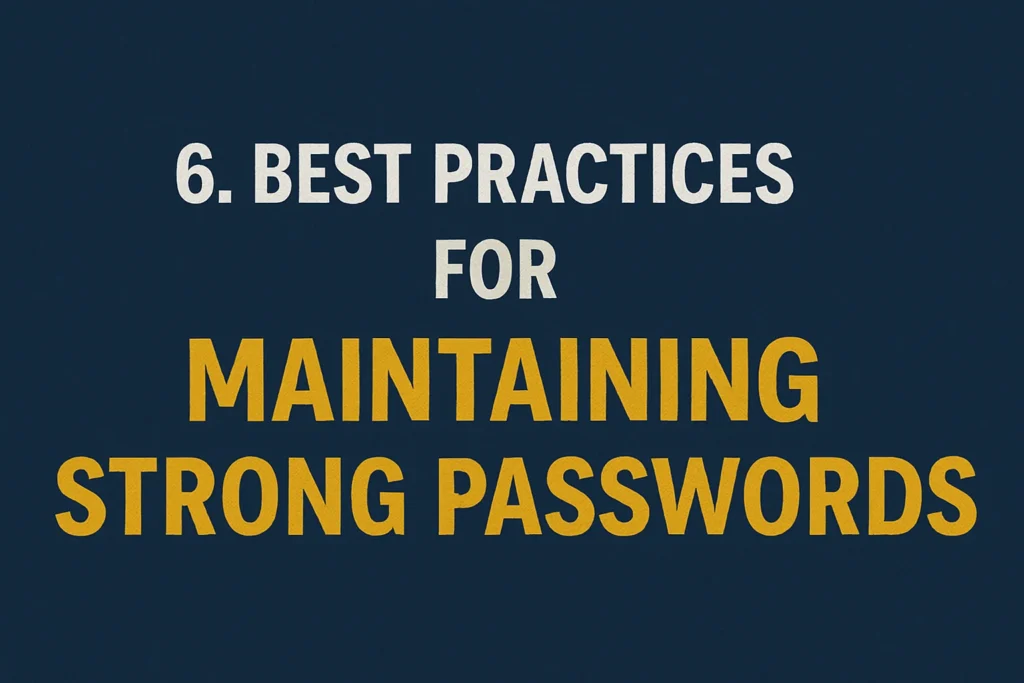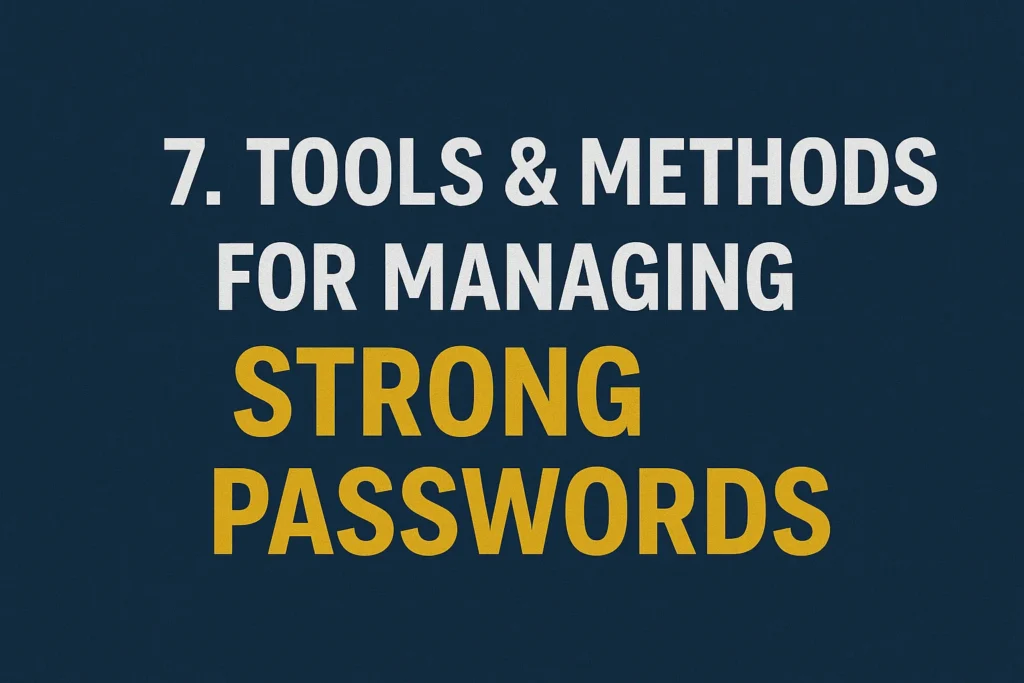Think about how much of your life is online: your emails, bank accounts, work logins, shopping profiles, and social media. Now imagine a stranger suddenly having access to all of it. They could drain your bank account, impersonate you, or lock you out of your accounts entirely.
In most cases, this nightmare begins with a weak password. Passwords are like digital keys; the stronger they are, the harder for anyone to break in. But here’s the problem: most people still use passwords that are too short, simple, or reused across multiple accounts.
In this guide, we’ll walk through how you can create and manage passwords that are both secure and easy to remember, why strong passwords matter, how hackers break them, and most importantly.
Table of Contents
1. The Importance of Passwords in Cybersecurity
Passwords are the first line of defense in the cybersecurity. They act like a lock on your account, preventing unauthorized access. No matter how advanced a website’s security system is, hackers can often bypass all other protections if your password is weak.
With the rise of phishing attacks, brute-force attempts, and data leaks, strong passwords have become more critical than ever. Think of them as your digital bodyguards; if well-trained and well-equipped, they’ll protect you. If they’re weak and careless, they’ll let anyone in.
2. Why Strong Passwords Matter?
A strong password doesn’t just protect your account; it protects your identity, your finances, and your privacy. Hackers often use stolen credentials to gain deeper access to your life, from opening bank accounts in your name to impersonating you online.
Weak passwords are like using a lock that hackers can easily open with a hairpin. Once it’s cracked, attackers can access multiple accounts, especially if you reuse the same password across platforms. The stronger and more unique your password is, the harder it is for anyone to guess or brute-force it.
3. How to Create Strong Passwords (Step-by-Step)

Creating a strong password isn’t about memorizing some secret hacker formula; it’s about combining simple rules and smart habits so your online accounts are safe, yet easy to manage. Let’s break it down step by step.
In this step-by-step guide, you’ll learn how to build secure, hacker-resistant passwords that are easy to remember but nearly impossible for others to guess.
1: Choose the Right Length
A password becomes increasingly difficult to break as its length grows.
- Minimum length: 12 characters
- Best practice: 14–16 characters or more
Long passwords take exponentially more time and computing power for hackers to break, making them far more secure.
2: Use a Mix of Characters
To make your password unpredictable:
- Combine uppercase and lowercase letters
- Add numbers
- Use unique characters such as @, #, $, %, and &.
- Example: F!reW@llS#cure92
3: Avoid Personal Information
Never use:
- Your name or username
- Birthdays, anniversaries, or addresses
- Pet names or family member names. This data type is often easy to find through social media or public records.
4: Skip Common Words & Patterns
Avoid:
- Dictionary words (e.g., “password”, “sunshine”, “football”)
- Keyboard patterns (123456, qwerty, abcd1234)
- Repeated characters (aaaaaa, 111111)
- These are the first guesses in hacking tools and password lists.
5: Create a Memorable Passphrase
A passphrase is a series of unrelated words combined into one long, unique password.
Example: GreenTiger!Climbs7Skies
You can make it even stronger by:
- Swapping letters with numbers (e.g., e → 3, a → @)
- Adding random symbols in between words
6: Use Unique Passwords for Every Account
Never reuse the same password across multiple accounts. If one account gets hacked, attackers could use the same password to break into your other accounts.
7: Update Passwords Regularly
Regularly update your passwords, giving priority to critical accounts such as email, online banking, and cloud storage. It reduces the risk of long-term compromise.
8: Use a Password Manager
Remembering dozens of complex passwords can be difficult. A password manager (like Bitwarden, 1Password, or LastPass) can:
- Generate strong, random passwords for each account
- Store them securely
- Autofill them when you log in.
9: Enable Two-Factor Authentication (2FA)
Whenever possible, activate 2FA for an extra security layer. Even if someone steals your password, you must provide a second verification step (like a text message code or authentication app).
4. Example of a Strong Password Creation Process
- Pick a phrase: CatsLoveClimbingMountains
- Replace letters with numbers/symbols: C@tsLov3Cl!mbingM0unt@ins
- Add extra randomness: C@tsLov3Cl!mb_2025_ingM0unt@ins
This password is lengthy, intricate, one-of-a-kind, and easy for you to remember.
Final Security Tip:
If remembering dozens of complex passwords feels overwhelming, a password manager + two-factor authentication (2FA) is your best combo for maximum security.
5. Common Mistakes People Make with Passwords
People often make the same dangerous mistakes when creating passwords despite knowing the risks. Here are some of the most common ones:
- Avoid using personal details, such as your name, birth date, phone number, or pet’s name, as they can be easily guessed.
- Short passwords: Hackers can crack anything under 8–10 characters quickly.
- Common words or sequences: passwords like “123456” or “password” are in every hacker’s playbook.
- Reusing passwords: using the same password for multiple accounts means one breach can compromise everything.
- Not updating passwords regularly: Data leaks may have exposed old passwords without your knowledge.
- Not using multi-factor authentication: Relying solely on passwords leaves your accounts vulnerable. MFA adds an extra verification step (like a code, fingerprint, or app approval), making it much harder for attackers to gain access even if they know your password.
These mistakes make a hacker’s job incredibly easy. Even with basic tools, they can guess a weak password in seconds.
6. Best Practices for Maintaining Strong Passwords

Creating a strong password is just the first line of defense; maintaining it adequately protects your accounts over time. Even the most complex password can be compromised if neglected, reused, or stored carelessly. These best practices will help you keep your passwords secure, up-to-date, and hacker-proof.
1. Change Passwords Periodically
While you don’t need to change your passwords every week, regular updates, especially for sensitive accounts like banking, email, or work logins, are a smart move.
- Tip: Change critical account passwords every 3–6 months.
- Why it matters: If a website suffers a data breach and leaks your password, updating it keeps hackers locked out.
2. Never Reuse Passwords Across Accounts
Using the same password for multiple logins is tempting, but this is one of the most dangerous habits. If hackers breach one site, they put all accounts sharing that password at risk.
- Use unique passwords for each account.
- Rely on a password manager to handle the complexity.
3. Enable Multi-Factor Authentication (MFA)
Hackers can steal even the strongest password. MFA adds an extra layer of verification, such as a text code, app authentication, or biometric scan, making it almost impossible for hackers to get in without your second approval.
4. Monitor for Data Breaches
You can’t always prevent a website from being hacked, but you can act fast if your credentials are compromised.
- Use services like HaveIBeenPwned.com or your password manager’s breach alerts.
- If a breach is detected, change the affected password immediately.
5. Avoid Public Wi-Fi for Logins
Logging into sensitive accounts on public networks (like cafes, airports, or malls) increases the risk of interception. If you must use public Wi-Fi, always connect through a VPN for encryption.
6. Log Out of Shared Devices
Whether using a public computer or borrowing a friend’s device, never stay logged in to your accounts. Always log out and clear browsing data afterward.
7. Be Alert to Phishing Attacks
Strong passwords won’t help if you give them away to scammers.
- Don’t click suspicious links in emails or messages.
- Verify website URLs before entering login details.
- Be wary of fake login pages that mimic legitimate sites.
Pro Tip: Think of password maintenance like locking your house, having a strong door lock is great, but if you leave the key under the mat or never check it for wear, you’re still vulnerable.
7. Tools & Methods for Managing Strong Passwords

Creating strong passwords is only half the battle, the real challenge is remembering them and keeping them organized without resorting to risky habits like writing them in a notebook or reusing the same one everywhere. That’s where password management tools and innovative methods come into play.
1. Password Managers – Your Digital Vault
A password manager is like a secure, encrypted safe for all your login credentials. You only need to remember one master password; the tool does the rest, such as generating, storing, and auto-filling strong passwords for each account.
Popular & Trusted Password Managers:
- LastPass: Cloud-based, easy to use across devices.
- 1Password: Strong security with travel mode for privacy.
- Dashlane: Built-in dark web monitoring and VPN.
- Bitwarden: Open-source and affordable, with robust encryption.
Benefits of Using a Password Manager:
- No more remembering dozens of complex passwords.
- Automatically generates random, unguessable passwords.
- Syncs securely across multiple devices.
2. Two-Factor Authentication (2FA) Apps
Hackers can steal even the strongest password if they breach a website. That’s why 2FA is essential. It adds a second layer of security, requiring a code from your phone or an authentication app before granting access.
Recommended 2FA Tools:
- Google Authenticator: Simple and widely supported.
- Authy: Backup and multi-device support.
- Microsoft Authenticator: Works with Microsoft and other platforms.
3. Secure Backup Methods
What if you forget your master password? Without a backup plan, you might lose access to all your accounts.
Safe Backup Practices:
- Write your master password on paper and store it in a locked safe.
- Use a secure USB key with encrypted storage.
- Keep recovery codes in a separate location from your primary device.
4. Avoiding Risky Storage Habits
You should avoid some methods at all costs because they are dangerous:
- Don’t store passwords in plain text (like in a notes app or Word file).
- Avoid browser auto-fill unless paired with strong device encryption.
- Never share passwords via email or text messages.
Pro Tip: If you struggle to remember even your master password, consider using a passphrase, a longer sentence-like password of random words (e.g., OrangeTigerDance42!), which is secure and easier to recall.
8. FAQs About Creating Strong Passwords
Q: What is a good way of creating a strong password?
Combine uppercase and lowercase letters, numbers, and special characters in a long, random sequence unrelated to your personal information.
Q: What is an example of a strong password?
A strong password might look like: R!ver&Sun97@Moon.
This password is secure because it:
1. It is long and includes mixed characters.
2. Avoids dictionary words and obvious patterns.
3. Has no personal connection to your name, birthdate, or hobbies.
Q: What is the 8-4 rule for creating strong passwords?
It suggests at least eight characters with four different types of characters (uppercase, lowercase, numbers, symbols).
Q: How do you generate a powerful password?
Either manually create one using random combinations or use a password manager to generate a secure and unique password for every account.
Final Thoughts
Your password is your digital armor. In an age where cybercriminals are becoming increasingly sophisticated, relying on weak or reused passwords is like leaving your front door wide open. By following the strategies in this guide, crafting strong, unique passwords and managing them securely, you can dramatically reduce your risk of falling victim to cyberattacks.
Security starts with you. Build strong passwords today, and you’ll thank yourself tomorrow.


